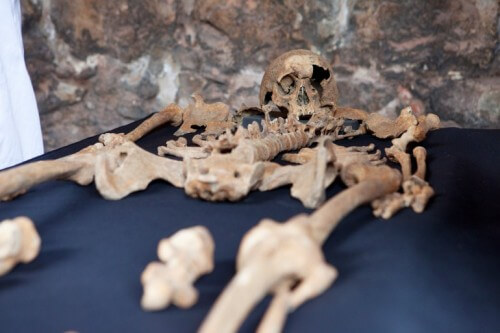The Black Death epidemic killed millions of people - a significant percentage of the inhabitants of Europe between the years 1347 and 1351. It reached the shores of Britain in 1348 and according to estimates it caused the death of about 60% of the island's population at that time.

Skeletons discovered in the excavations of a railway tunnel that crossed London (Crossrail) are part of a mass grave of victims of the Black Death - the great plague of the 14th century. This is shown by forensic tests conducted on the skeletons.
The archaeologists, employed by the Crossrail company and accompanying the excavation project, reveal that their teeth contain DNA from the plague bacterium Yersinia pestis and their graves date from 1348-1350. According to the records of the time, thousands of Londoners perished in the plague and their bodies were dumped in a mass grave outside the city, but its exact location was a mystery. Archaeologists now believe it is now under Charterhouse Square near the Barbican.
They plan to expand their search for more victims in the square area with the help of underground radar scans, and there are already signs of many graves in the vicinity.
Crossrail's chief archaeologist Jay Carver says a 660-year-old mystery has been solved. "This discovery is a huge step forward in documenting and understanding Europe's most devastating epidemic," he said. "Continuation excavation will be carried out to see if - as we expect - we will reach a much larger mass burial trench."
The Black Death epidemic killed millions of people - a significant percentage of the inhabitants of Europe between the years 1347 and 1351. It reached the shores of Britain in 1348 and according to estimates it caused the death of about 60% of the island's population at that time. In London, two emergency mass graves were dug outside the city wall, one was discovered in Smithfield, and the other somewhere in the Farrington area. In March 2013, railway engineers excavated 25 skeletons in a 5.5 meter diameter shaft alongside pottery dating to the mid-14th century.
Samples from 12 of these skeletons were taken for analysis in a forensics laboratory, and it turned out that DNA remains of Yersinia pestis were found in at least four skeletons, indicating that they were in contact with it before their deaths. To determine which of these eruptions the 25 bodies belong to, the researchers performed radioactive carbon dating. It turns out that the burial site was used in two separate periods - during the first outbreak in 1348-50 and eighty years later, around 1430.
The skeletons also teach more details about that period.
* All the skeletons appear to have suffered from malnourished Chinese and 16% had rickets of the bones
* 40% of those surveyed grew up outside of London, possibly even coming from Scotland, suggesting that 14th century London attracted people from all over Britain as it does today.
* The latest skeleton suffered a high rate of injuries to the upper half of the body, indicating that it was involved in a violent event.
* One of the people became a vegetarian late in life, as Carthusian monks practiced in the 14th century.
* 13 of the skeletons were of adult men, three of adult women, two children (boys), and the gender of the other seven was not clear.
* The study reinforces the hypothesis that the burial area was used by the poor of Lanodon.
* A high rate of back injuries and muscle damage indicate hard physical work.
For information on the CROSSRAIL website
More of the topic in Hayadan:
The cow that defeated the black death
Rats in the service of God

3 תגובות
Is there a danger of being infected with the thing from the skeletons, can things viruses survive for a long time on the skeletons?